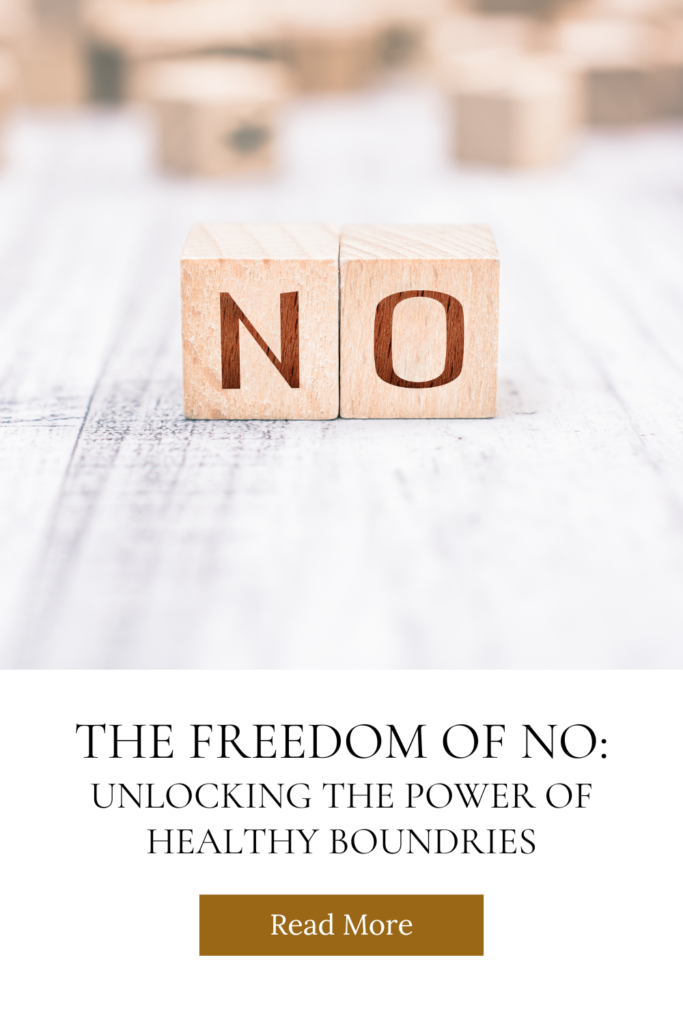The Freedom of No: Unlocking the Power of Healthy Boundaries
Ready to change your life with one simple word? Say hello to “No.” This tiny word packs a powerful punch, giving you the freedom to protect your peace, prioritize your well-being, and create a life that truly reflects your values. But let’s face it—saying no isn’t always easy. Whether it’s the fear of letting others down, the urge to be liked, or just not knowing how to assert ourselves, “no” can get stuck in our throats. But here’s the good news: mastering the art of saying no isn’t about being difficult—it’s about setting boundaries that help you thrive. As my cousin wisely taught me, “Someone’s reaction to your boundary is not your problem.” Let’s dive into how you can harness the liberating power of no.
Why Boundaries Are Your Secret Superpower
Think of boundaries as your personal force field, defining what’s acceptable in your relationships, work, and personal life. They protect your time, energy, and mental health. Without them, you risk feeling overwhelmed, resentful, and burned out. Setting boundaries is a radical act of self-respect—and trust me, you deserve it.
The Power of Saying No
Saying no can be life-changing. It frees you from obligations that don’t serve you and gives you the space to focus on what truly matters. When you say no to things that drain your energy or clash with your values, you’re saying a big, bold YES to yourself. You’re prioritizing your needs, goals, and well-being.
Ready to master the art of no? Here are 10 tips to help you say it with confidence and grace:
1. Know Your Priorities
Before you can set boundaries, you need to be crystal clear about your priorities. What lights you up? What are your non-negotiables? Knowing what matters most makes it easier to spot when something doesn’t align with your values or well-being.
How to Practice: Make a list of your top priorities and keep it somewhere visible. Let this be your compass, guiding you to focus on what truly matters.
2. Tune Into Your Emotions
Self-awareness is your best friend when it comes to boundaries. Pay attention to your feelings in different situations. Feeling drained, stressed, or resentful? These are signs that your boundaries might be getting crossed. By tuning into your emotions, you can identify when it’s time to pull out that powerful “no.”
How to Practice: At the end of each day, take a few minutes to reflect. Did anything make you feel uneasy? Use these insights to tweak your boundaries where needed.
3. Be Bold, Be Direct
When it’s time to say no, keep it clear and direct. You don’t need to explain or apologize excessively. A simple, “No, I can’t do that,” or “I’m not available,” works wonders. Remember, “no” is a complete sentence!
How to Practice: It might sound silly, but practice saying no in front of a mirror or with a friend. The more you practice, the more natural it’ll feel.
4. Offer Alternatives (If It Feels Right)
If saying no feels tough, especially to someone you care about, consider offering an alternative. Can’t make it to that event? Suggest catching up over coffee next week. This shows you value the relationship while still honoring your boundaries.
Tip: Only offer alternatives if it feels genuine. Don’t feel obligated to offer a substitute every time you say no.

5. Stand by Your Boundaries
Setting boundaries is one thing, but enforcing them is where the magic happens. Respecting your own boundaries means not letting others push you beyond what’s comfortable. If someone tries to guilt-trip you into saying yes, stand firm. Your well-being comes first.
Tip: If enforcing boundaries feels tough, remind yourself why you set them in the first place. This will help you stay strong.
6. Embrace the Awkwardness
Saying no can feel awkward, especially if you’re a people-pleaser. But here’s the thing—discomfort is part of growth. The more you practice setting boundaries, the easier it becomes. And guess what? The benefits far outweigh the initial awkwardness.
Tip: When you feel the discomfort of saying no, take a deep breath. Remind yourself that prioritizing your needs isn’t selfish—it’s self-care.
7. Remember: No Isn’t Rejection
One of the biggest hurdles to saying no is the fear of rejection or hurting someone’s feelings. But here’s the truth: saying no isn’t rejecting the person—it’s choosing what’s best for you at that moment. Most people will understand, and those who don’t might not have your best interests at heart.
How to Practice: Reframe your thinking. See saying no as an opportunity to set healthy limits and nurture your well-being.
8. Give Yourself Permission to Rest
In a world that glorifies busyness, it’s easy to feel guilty for resting. But rest is essential for your mental and physical health. Saying no to extra tasks or social events gives you the chance to recharge and return stronger.
Tip: Treat your rest as non-negotiable. Schedule it in your calendar like any other important appointment.
9. Seek Support When You Need It
Setting boundaries can be tough, especially if you’re new to it. Don’t hesitate to seek support from loved ones, a therapist, or a coach. Having someone in your corner can make all the difference.
Tip: Surround yourself with people who respect your boundaries. A supportive community is a game-changer.
10. Celebrate Your Wins!
Every time you say no and set a healthy boundary, you’re making progress. Celebrate those wins, no matter how small. Acknowledging your growth will boost your confidence and reinforce the importance of maintaining your boundaries.
Embrace the Freedom of No
Mastering the art of saying no is a journey, but it’s one worth taking. By setting healthy boundaries, you’re not only protecting your peace—you’re creating a life that aligns with your values and priorities. Remember, saying no isn’t about shutting people out—it’s about making room for what truly matters to you. So go ahead, embrace the freedom of no, and watch how it transforms your life for the better.
How have you set boundaries in your life? Share your experiences in the comments below!




